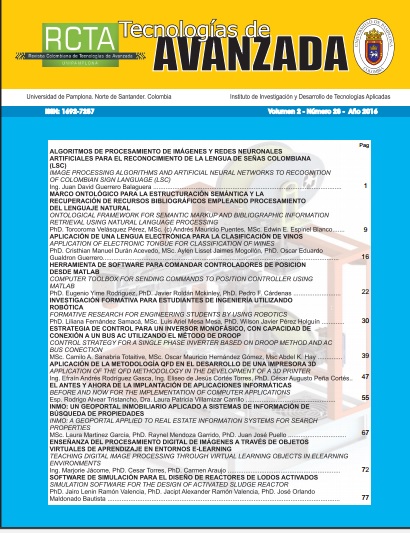Non-invasive electronic device for remote measuring physiological signal in canines
DOI:
https://doi.org/10.24054/rcta.v3iEspecial.854Keywords:
Adiestramiento canino, DSP, ECG, instrumentación, frecuencia cardiaca y respiratoriaAbstract
This article describes the development of a non-invasive electronic device, which performs the measurement of physiological signals in real time in canines at the service of the National Army, especially those who are in training for the detection of controlled substances (explosives, narcotics, foreign exchange). , search and rescue); The measured variables are the heart rate, respiratory rate and temperature, which allow determining the real physical condition of the animal, preventing physical efforts that affect the canine's response to training. The physiological signals are; Visualized and analyzed in real time to determine heart and respiratory rates, displaying the results in an intuitive graphical interface that allows the trainer to determine changes in training routines andrest times.This article is structured in three parts: in the first part, the different techniquesand equipment used by veterinary doctors to estimate physiological variables are studied. The second part focuses on hardware selection and prototype implementation. In the last part, the data obtained with the prototype and those acquired by a veterinarydoctor are compared.
Downloads
References
Bell, J., Cavanagh, K., Tilley, L., & Smith, F. (2012). Veterinary Medical Guide to Dog and Cat Breeds. In Veterinary Medical Guide to Dog and Cat Breeds. https://doi.org/10.1201/b16185
Brloznik, M., Likar, Krvavica, A., Avbelj, V., & Domanjko Petric, A. (2019). Wireless body sensor for electrocardiographic monitoring in dogs and cats. Journal of Small Animal Practice, 60(4), 223–230. https://doi.org/10.1111/jsap.12963
Brugarolas, R., Dieffenderfer, J., Walker, K., Wagner, A., Sherman, B., Roberts, D., & Bozkurt, A. (2014). Wearable wireless biophotonic and biopotential sensors for canine health monitoring. Proceedings of IEEE Sensors, 2014-Decem(December), 2203–2206. https://doi.org/10.1109/ICSENS.2014.69854 77
Brugarolas, R., Yuschak, S., Adin, D., Roberts, D. L., Sherman, B. L., & Bozkurt, A. (2019). Simultaneous monitoring of canine heart rate and respiratory patterns during scent detection tasks. IEEE Sensors Journal, 19(4), 1454–1462. https://doi.org/10.1109/JSEN.2018.2883066
Eldredge, D. M., Carlson, L. D., Carlson, D. G., & Giffin, J. M. (2007). Dog Owner ’ s Home VETERINARY.
General, S., & Albert, P. (2007). Federation cynologique internationale (aisbl) - Tornjak. 1–8.
Gomez, L., & Atehortua, C. (2007). La influencia de las mascotas. Revista Colombiana de Ciencias Pecuarias, 20, 377–386.
Grigg, E. K., & Donaldson, T. M. (2017). The Science Behind a Happy Dog (First). 5M Pusblished Ltd.
Hamada, R., Ohno, K., Matsubara, S., Hoshi, T., Nagasawa, M., Kikusui, T., Kubo, T., Nakahara, E., Ikeda, K., Yamaguchi, S., Yamakawa, T., & Tadokoro, S. (2017). Real- time emotional state estimation system for Canines based on heart rate variability. 2017 IEEE International Conference on Cyborg and Bionic Systems, CBS 2017, 2018-Janua, 298–303. https://doi.org/10.1109/CBS.2017.8266120
Horwitz, D. (2018). Canine and feline behavior. https://doi.org/10.1192/bjp.112.483.211-a
Instrument, N. (2018). USER GUIDE AND SPECIFICATIONS NI myRIO-1900.
Melexis. (2019). MLX90614 family Single and Dual Zone Datasheet. In Melexis Inspired Engineering. https://www.mendeley.com/catalogue/mlx90 614-family-single-dual-zone-infra-red- thermometer-to39/
Oostendorp, T., MacLeod, R., & van Oosterom, A. (1997). Non-invasive determination of the activation sequence of the heart: Validation with invasive data. Annual International Conference of the IEEE Engineering in Medicine and Biology - Proceedings, 1(C), 335–337. https://doi.org/10.1109/iembs.1997.754543
Organización Mundial de Salud Animal. (2012). Federation cynologique internationale (aisbl). 1–6.
Popov, A. N. (2005). Realization of Digital Filters on PIC - Microcontrollers. 2005 11th International Scientific and Practical Conference of Students, Post-Graduates and Young Scientists - Modern Technique and Technologies, 40–41. https://doi.org/10.1109/SPCMTT.2005.4493 171
Ramón Meder, A. (2010). Utilidad de la electrocardiografía en la clínica veterinaria de animales de compañía. Ciencia Veterinaria, 12(1), 39–43. http://search.ebscohost.com/login.aspx?direct =true&db=a9h&AN=79892161&lang=es&si te=ehost-live
Santamarina, G., Pernas, Álvarez, R. T., & Rey, M. L. S. (1998). Eletrocardiografía. Consulta de Difusión Veterinaria, 15(I), 01–52.
Schonle, P., Wang, Q., Brun, N., Bosser, J., Meier, P., & Huang, Q. (2018). Towards an implantable telemetry system for SpO2 and PWV measurement in small animals. 2017 IEEE Biomedical Circuits and Systems Conference, BioCAS 2017 - Proceedings, 2018-Janua(2), 1–4.
Ynaraja, E. (2010). Guía de auscultación clínica en perros y gatos. 1–25.
Downloads
Published
Versions
- 2020-08-14 (6)
- 2020-08-14 (5)
- 2020-08-14 (4)
- 2020-09-01 (3)
- 2023-07-19 (2)
- 2021-04-13 (1)
How to Cite
Issue
Section
License
Copyright (c) 2020 REVISTA COLOMBIANA DE TECNOLOGIAS DE AVANZADA

This work is licensed under a Creative Commons Attribution-NonCommercial 4.0 International License.














